Author: Swarnali Adhya
Creative writer and blogger in Inovar Consulting. She is enthusiastic to learn new things, increase opportunities in professional field and work as a proactive member in team collaboration. A bibliophile, food lover and music lover.
Robotic process automation or RPA has the power and capability to help organizations increase their output and accelerate their digital transformation agenda. The true benefit of RPA rests on the technology’s ability to increase efficiency while reducing costs. There is no surprise that RPA is gaining traction in the market by taking away repetitive manual tasks from the human workforce and freeing them to focus on more critical strategic functions.
6 steps to use RPA in an effective way
1. Identify the process
The first thing is to carry out a thorough assessment of all the operations, within and across various departments, so that you can determine which processes can prove to be good candidates for automation.
2. Manage expectations:
Implementation of RPA is all about managing the people and their expectations. Employees must be informed about the need for automation, its essentiality, and how it is likely to influence the return on investment (ROI). The most important areas in which you need to manage expectations are:
- Implementation time
- Implementation cost
- Cost savings
- Benefits of analytics
3. Choose the right tool
Another vital task is to have a crystal-clear set of objectives that your company aims towards. There you can follow two criteria. First, you can consider vendor-related criteria, such as their experience or their orientation to future-proof automation solutions.
Another way, you can try to match the RPA software features, like security and screen scraping capabilities, ease of implementation, the total cost of ownership, etc., to your company’s hierarchy of goals and needs.
4. Assessment of ROI
A fine-grained analysis is required for analysis of the feasibility required before successful RPA implementation. It is important for every organization to compare investment against return, and to decide based on this to what extent it is profitable to invest in RPA.
5. Involve your IT team
The members of your IT team can provide critical insight as you choose an RPA tool that meets your business objectives. Their expertise will also be valuable whenever unexpected issues or malfunctions occur. Training for other employees will be also easy with their support.
6. Measuring the performance
Finally, formulate key performance indicators (KPIs) based on which you can find out the success rate of your RPA implementation.
Inovar blends diligence with skill
Inovar delivers state-of-the-art smart solutions by blending diligence with skills. We adhere to the aforementioned steps and identify what processes/functions need to be automated.
Considering the massive importance and benefits of RPA solutions in reducing efforts, improving customer service, and increasing profits, proper implementation becomes pivotal to ensure that every step is duly scrutinized, vetted, and backed.
Take full advantage of the cloud computing model by containerizing the applications and building microservices for agility, flexibility, reproducibility & transparency.
Build new applications and modernize the existing ones in accordance with the principles of the cloud that are optimized for the utilization of product development & faster service delivery to your customers.
Benefits of Cloud-Native Application Platform
1. Faster Release
The faster an organization can conceive; build & ship software determines their market stand against the competition.
User demand for new functions grows faster than your development processes can meet. You need a platform, methods, application services, and tools that can keep up without forcing you to leave behind the existing apps that your customers depend on. Cloud development methods – DevOps and agile – also guide cloud projects forward at a fast pace and resolve bottlenecks in a short time.
2. Easy Management
Serverless platforms like Azure function & AWS Lambda take the hassle out of managing infrastructure so that you don’t worry about configuring the networks, allocating storage, or provisioning cloud instances, etc. as an example.
3. Cost Savings
Standardization of infrastructure & tooling across many cloud platforms helps reduce costs for organizations by containerizing the applications independent of the platform. An example of such is the open-source Kubernetes platform which is standard for managing resources on the cloud.
4. System Reliability
By using approaches like Microservices & Kubernetes you can build applications that are fault-tolerant with self-healing built-in. These approaches prevent an entire application from being affected or taken down when a technical failure hits thus allowing you to isolate and work on the impacted area alone.
5. Scalability
Who doesn’t want the business to grow? With a growing business comes a growing scale of application use. Cloud-native development allows you to be worry-free of the growing scalability by optimizing the applications scale automatically with you paying only for the services used.
Are you looking for some consultation on how you can achieve the above benefits? Email your queries or get in touch with one of our representatives & we’d love to get back to you.
About Inovar Consulting
Inovar delivers state-of-the-art smart solutions through its Consulting evangelists who help businesses identify and integrate emerging technologies and software initiatives that create a trusted customer experience and camaraderie.
As the world is moving to Industry 4.0 standards and some countries formalizing these standards, workflow automation is going to play a central role as a driving force for telecom organizations. Workflow Automation reduces the time and costs it takes to activate and provision services, thereby increasing the acquisition of end-users.
Workflow Automation
Huge traffic and signal compliance create difficulties to collaborate with peer networks, understand their difficulties, and reach out to the right contact network for a possible solution.
SharePoint resolves the problem of seamless collaboration and communication between internal stakeholders – different teams, departments & geographies.

By implementing SharePoint Online telecom organizations can move a lot of their vital collaboration tools to the cloud, enabling peer networks to share problems and concerns, access a single content from a different point, and add value while on the move. With the offline access feature, all data automatically gets synchronized between SharePoint Online and local computers whenever a network connection is available.
SharePoint Online offers a real-time co-authoring feature to enable the stakeholders to collaborate in real-time.
Our proficiency in providing SharePoint solution
Our US telecom client was facing collaboration and communication issues due to an improper and interrupted operation. According to Shivsankar Barik, VP Delivery of Inovar Consulting, the main challenge was that our client’s organization had an issue in collaborating with peers and reaching out to the right SPOCs to find important information.
Our target was to provide them with an automated technical solution to ensure effortless operations and uninterrupted communication. We cut down their time to market and improved their operational efficiency with a 40% improvement in site/signal compliance achieved with the help of big data analytics and helped them migrate from SharePoint on-premise to SharePoint Online. The entire automated environment enriches the visualization and monitoring power in a network. It also provides real-time alerts to avoid any sudden failure.

“What started as workflow automation solution, resulted in huge cost savings optimizing end to end process”- Apratim Ghosh (CEO, Inovar Consulting).
We have come a long way since then having managed their existing SharePoint Sites, built net new sites for different teams. Data security and access control are other vital concerns of our clients. We deploy a hybrid cloud solution applying next-gen technology for controlling access with better data security.
Automated telecom infrastructure with a customer-centered, data-driven culture can drive profit, increase productivity and significantly reduce costs. If you are also looking for an automated technology solution to manage your telecom networking and communication systems feel free to reach out to us.
SaaS or Software as a Service is making a buzz in almost every industry, and logistics is no exception. Businesses across the globe prefer SaaS-based logistics software instead of investing in developing on-premises software that might take several months or even a year to build. To understand why this shift is happening- let’s first understand what are the problems the logistics industry is facing? And how SaaS-based applications can be a perfect solution for them.
SaaS is a mechanism of transferring software to everyone (individual or business) over the internet. In this nature of software licensing and release model, the license of the software can be availed periodically. The software is centrally introduced in the cloud, and the individual, availing SaaS access through any compatible browser.
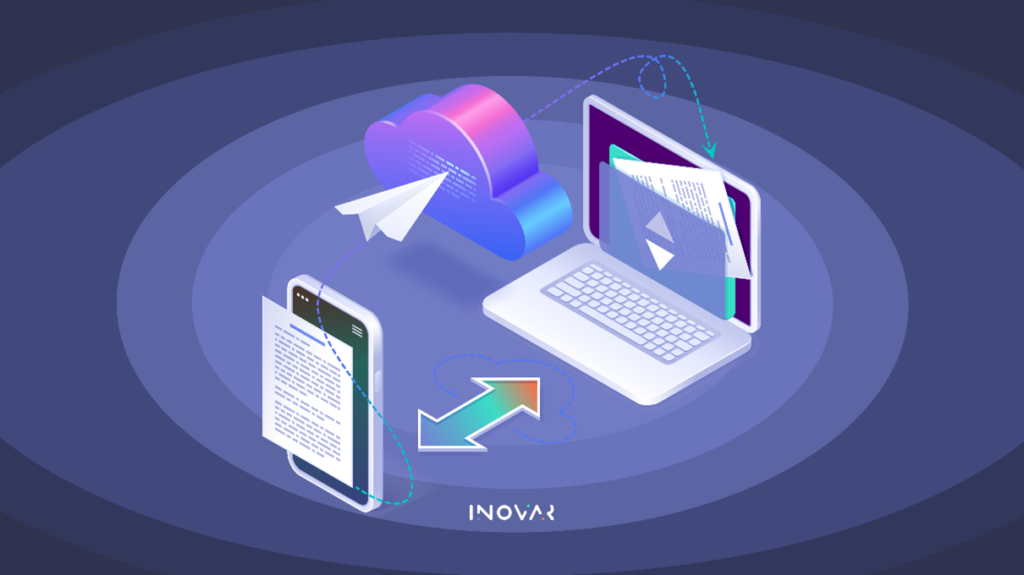
Present industry challenges:
Transportation and logistics industries are constantly struggling with challenges- like complex competition, changing customer expectations, and leveraging digitization to succeed. Lack of ‘digital culture and training is thus the biggest challenge for these companies. Attracting the right skills is one issue, but developing the right strategy is even more crucial.
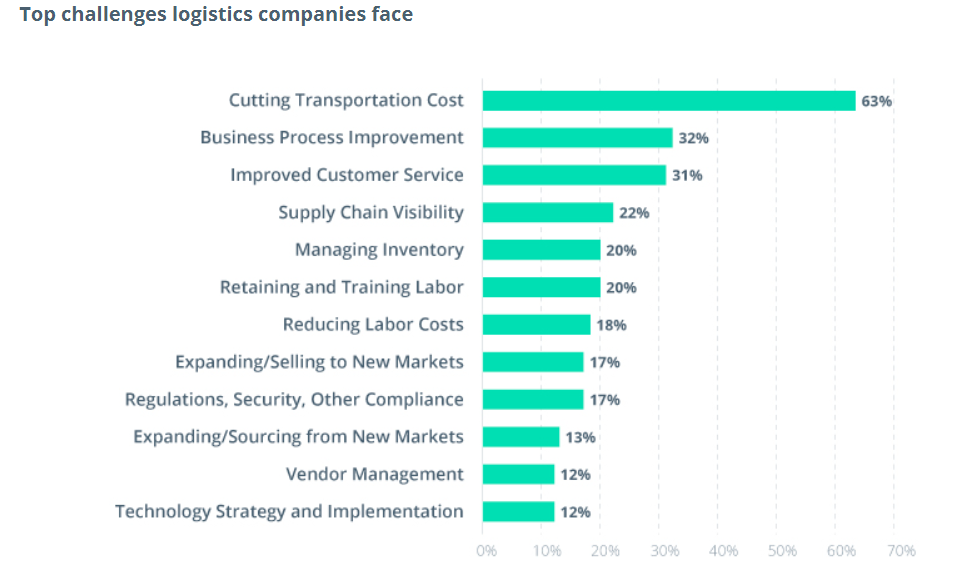
Besides, an increasingly competitive environment is another dominant factor in the mix. Some of the sector’s customers are springing logistics services of their own, and different competitors to the business are shaping out more profitable aspects of the value chain by exploiting digital technology or brand-new ‘sharing’ business models. They don’t have asset-heavy balance sheets or cumbersome existing arrangements weighing them down.
There is no other industry where so many experts ascribe vast influence on data and analytics in the next five years than transportation and logistics. There are vast possibilities to enhance performance and serve customers better, and LSPs who are part of a digitally integrated value chain can benefit from significantly increased forecasting to scale up capacity or down and plan routes. Adding machine learning and artificial intelligence techniques to data analytics can deliver truly dynamic routing.
Business solutions
One of the most promising ways for transportation companies to improve their workflows and find new ideas for business growth is using a custom SaaS system. These systems guarantee more agile data processing and greater automation of operations than out-of-the-box solutions. They also allow companies to build only the features they need.
From streamlining processes to increasing visibility in the supply chain, their pertinence has grown in quality. According to Statista, 87% of logistics and supply chain firms are tapping into cloud-based solutions to facilitate transportation management and gain an edge in an ever-changing marketplace.

Businesses can optimize SaaS solutions to automate the logistics workflow and free employees from performing routine tasks connected with paperwork.
Logistics is a sphere of multitasking and multiprocessing. Robust SaaS solutions are essential for tracking details and conducting analysis, which helps businesses detect issues and optimize their work. They are designed to simplify and manage complicated logistics problems by taking an integrated, end-to-end approach. The functionality enables optimal route planning, reductions in fuel costs, and significant improvements in asset utilization
.

Logistics companies gain real-time visibility from SaaS solutions into logistics processes and data, assisting businesses to keep their operations under command. SaaS logistics solutions support companies to reach a more predictable supply chain, while companies can associate in the cloud to cooperate efficiently.
SaaS solutions empower operators to access high-level route planning abilities on demand, encouraging them to avoid the high capital cost investment and the in-house IT staffing required for superior systems integration. We can directly scale them up or down according to business needs without infrastructure changes as they are delivered as a service.
Inovar optimized SaaS solution for logistics
Inovar joined hands with fleet operators to manage their logistics operations and apply technology for making their workflow automated. With an AI-powered SaaS solution, we gave fleet operators ways to predict demand, optimize vehicle usage, and give them real-time tracking of their vehicles from both fleet operators and consumers.
Our first aim was to bring all stakeholders Markets, Warehouses, Traders, Ports, and Truckers under a single virtual platform and allow them to trade on-demand within an open marketplace.
Inovar brought Microsoft Azure IoT and machine learning services within a customized application that could build a connected platform for fleet operators. The solution could not only gather data efficiently but generate intelligence as it was used. Another remarkable feature was analytics and event hubs that captured data used in a Databricks platform to generate insights. Using these insights, system booking, scheduling, predictive maintenance cycles became 70% easier than before.
Finally, the system went live with 1000+ vehicles, and the logistics client started to reap ROI from multiple avenues. Within 3 months, the efficiency of their operations improved by 30% with better security, high scalability, and faster availability from the end-user.
Summing up, we can say that cloud logistics automation is beneficial to all participants in the supply chain. It allows you to easily solve complex problems, so its popularity will only grow every year. As a logistics software development partner, we solve many standard and custom needs of the transportation industry from Business as well as Technology perspectives. After many years spent in the logistics domain, our dedicated development team learned specific details and gained experience that can be used to effectively help you with any of your logistics software that you need to develop.
InovarTech is ready to improve your automation experience. With our brilliant forms and streamlined workflows, you will be fit to tackle process technologies and know-how to adapt them to your institution. Reach out to us today to get started. You can take comfort because we know process automation and how to implement them effectively. Let us deliver high-volume processes to your doorstep.
The pandemic has changed how people around the world live, work, and engage with each other. In late 2019 when covid-19 struck the world, affecting millions of people all over the planet — the healthcare industry was hit the most. The pressing need for resources, information, cost optimization, and supply chain inefficiencies in the sector calls for a major technology overhaul. Therefore, embracing new-age digital technologies is key for healthcare providers in addressing the immediate concerns and driving long-term goals.
Automation makes a revolutionary process change in most of the industries, that has the same or even more potential for the healthcare sector. Introduction of Business Process automation can streamline the healthcare system for simplicity, increase service quality, and manage pen and paper-based manual tasks, saving time and cost without the slightest glitch.
Challenges in Healthcare
Application Disparity: Modern healthcare is a complex environment where many disparate applications work. The complexities also grow with the business. With mergers and acquisitions, modern technologies are adopted to meet new challenges. In this situation managing all technology becomes quite difficult for the healthcare IT departments and business users.
For example, in most healthcare sectors, patient data transfer is still carried out manually in the form of files and documents from one department to another. As the volumes of data are generally high, compiling them in one single process is a tedious and lengthy process. Not to forget, since they are done manually, there is always scope for multiple human errors and miscalculations. The greater the rate of error, the more the cost will be for rectification.
Lack of efficiency in patient service is another challenge that can be a barrier to your organization’s growth and reputation. In most scenarios, customer care executives are busy with paper works and other files and documents compilation that they lack prompt and timely delivery of services to the customers.
I hope you can relate to the problems I discussed above. So now I am going to share how automation becomes an integral part to solve some of healthcare challenges.
The business automation software works on all programs whether, new applications, legacy programs, cloud-based solutions, or on-prem.
BPA makes human-oriented processes much smoother with greater results like increased speed, productivity, and efficiency. Suppose for a patient, scheduling an appointment with a doctor usually happens online in a matter of minutes, but what happens behind the scenes is a bit more complicated. Healthcare institutions have to collect personal information, diagnosis, insurance details, and confirm the doctor’s availability. If the right information cannot be accessed during the registration process, or if the doctor is not available, it is up to the staff to inform the patient beforehand.

Implementing automation can resolve some of the bottlenecks related to scheduling patient appointments. Bots can automate patient data collection and processing, so patients can be optimally scheduled according to diagnosis, location, doctor availability, and other criteria. By simplifying appointment scheduling, healthcare institutions can focus their efforts on providing exceptional service and other tasks that cannot be automated. Automation tools also enable customer care executives to take the assistance of such tools with automated call and email options.
Inovar proposed Automation Solutions with better ROI
Something similar also happened with one of our US healthcare clients. They were also facing customer support challenges during the pandemic. They were primarily using a pen and paper-based system for information collection and symptom analysis. After the outbreak of the virus, a lot of patients started asking for support in their chatbot regarding diagnosis, vaccination, and other medical support.
With a lot of restrictions, it becomes necessary to give patients the capability to run the assessments on their own from the comfort of their homes. Remote work capability also became especially important, and they needed an infrastructure through which they can achieve that.

To manage the entire scenario, they required VPN, which was not designed for such large-scale use resulting in low bandwidth and frequent outages. Additionally, a lot of the content and manual workflows required the physical presence of the employees on the hospital premises that was quite impossible at that moment.
In this critical situation, the first hurdle to cross was to get them to a cloud-based solution to ride care facilities across all their nation-level operations and provide the best health support to patients. This would make remote work possible for the hospital staff in case they were showing symptoms and had to quarantine at home.
In this situation, Inovar helped a leading US healthcare organization to automate their Covid-19 Helpdesk and Registration process from a pen and paper-based manual system to a cloud-based automated solution.
SharePoint Online became the choice of the platform along with Power Platform as their primary productivity technologies allowed them to create a technology framework with a built-in rapid growth mechanism and assist hospital staff to manage the entire remote work process.
With the implementation of the initial solution, the healthcare organization was also facing challenges to roll out the solution in all other locations of the US that becomes much fair with SharePoint and the power platform.

A simple but practical experience gained a high adoption rate within the healthcare organization. The organization’s IT team also considered it as the best rollout experience with almost a zero-touch provisioning and deployment strategy. Ultimately, with all these solutions 90% of their remote and quarantined caregivers were able to serve the patients over remote calls and Online consultation.
The digitization of call centers was a major bonus as it consisted of Automated Diagnosis for Covid, automatic decision-making capabilities, and other similar tools that ensured self-help services that were non-existent before. This resulted in a reduction of 70% in phone calls.
Businesses transitioning from manual processes to comprehensive workload automation tend to go through several phases on their automation journey. If you are also facing the same difficulties within your organization, then Inovar is the best partner to collaborate with and make your automation journey smoother. Feel free to reach out to us we would love to collaborate!
With the fast pace of cloud changes, cloud lock-in remains a popular refrain. But do you know what does it mean? How can you make sure that you’re boosting your cloud investment at the same time maintaining portability in mind?
In this article, we are going to talk about how business owners and analysts will strategize the best cloud approach to maximize their ROI and gain ten times better solutions with the proper cloud architecture.
Cloud bursting! Hybrid cloud! On & Off-premises! Multi-cloud! Cloud strategists, analysts, and architects are aware of these phrases over the past ten years. Each of them makes logical sense, but in recent times, it’s the last – multi-cloud – that I’ve seen in actual practice the most.
If you are not clear about what multi-cloud is — let me explain!
What is multi-cloud?
Multi-cloud is the utilization of two or more public and/or private cloud providers to assist the IT services and infrastructure of an organization. A multi-cloud strategy typically consists of a mix of primary public cloud providers particularly, Amazon Web Services (AWS), Google Cloud Platform (GCP), Microsoft (Azure), IBM, and Alibaba.
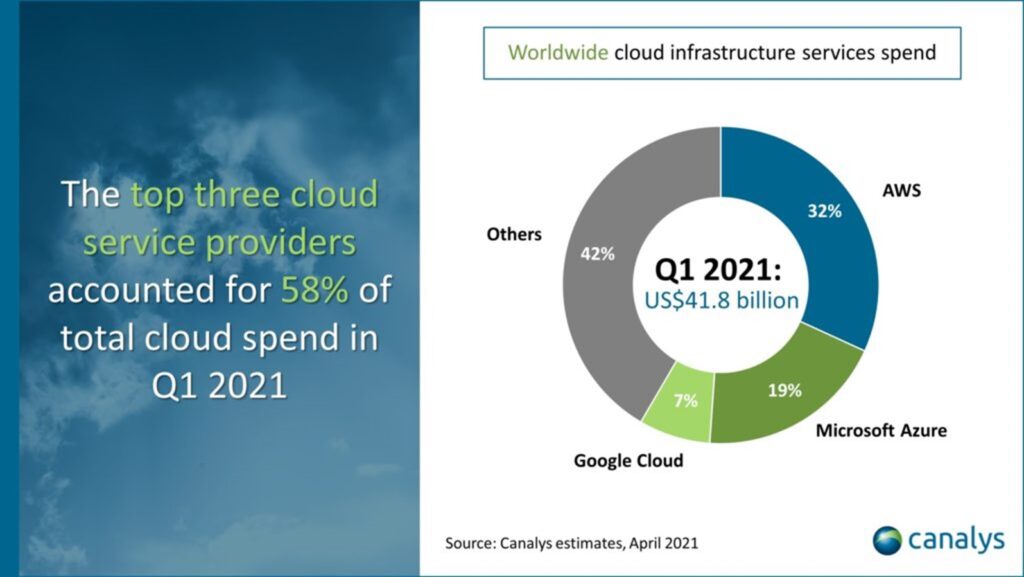
Businesses that embrace a multi-cloud architecture may leverage various public clouds in combination with private cloud deployments and traditional on-premises infrastructure.
Organizations prefer the best services from each cloud provider based on values, technical specifications, geographic availability, and other factors. Each day, every organization practices multiple types of data and diverse applications. Most of the cloud vendors specialize in a particular area, so being able to use different clouds encourages companies with the agility they need. This may mean that a company uses Google Cloud for development/test while using AWS for disaster restoration and Microsoft Azure to concoct business analytics data.
What is a multi-cloud strategy?
A multi-cloud environment can combine SaaS, PaaS, and IaaS deployments from more than one public or private cloud service provider to meet an organization’s technical and business needs.
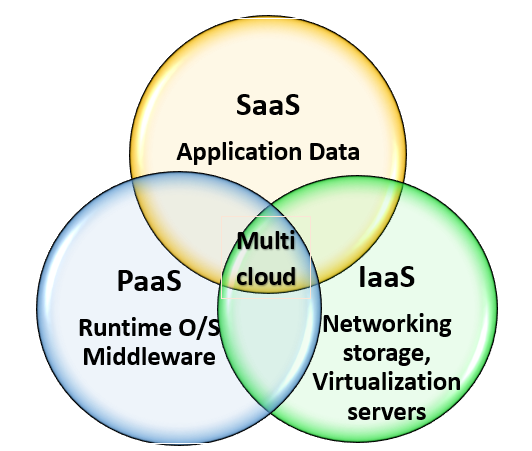
For example, many businesses initially jump into the cloud tepidly, at least one small service or application at a time. Shortly, this converts unwieldy, and you have to clean up your cloud sprawl. Hence, you need a strategy.
A multi-cloud approach empowers organizations to advance the efficiency of their IT spending and business operations by preferring an appropriate service and provider for each use case. The main concern of every organization is to reflect their needs are and align their needs with the best cloud providers applying a multi-cloud strategy. The forester industry analysts conducted an in-depth analysis of over 600 cloud strategy professionals to determine the leading use cases for multi-cloud architecture.

Below we have discussed the modern use cases for a greater understanding—
- Selectively deploying application workloads over multiple public and private clouds depends on the application and business needs.
- Combining on-premises infrastructure and services from multiple public clouds in a hybrid cloud environment.
- Evolving API-consistent cloud architecture across both public and private clouds.
- Developing data-center abilities and extending disaster recovery capabilities.
- Governing access to cloud-based data, applications, and services within a specific control portal.
- Advancing applications with components deployed to various cloud platforms.
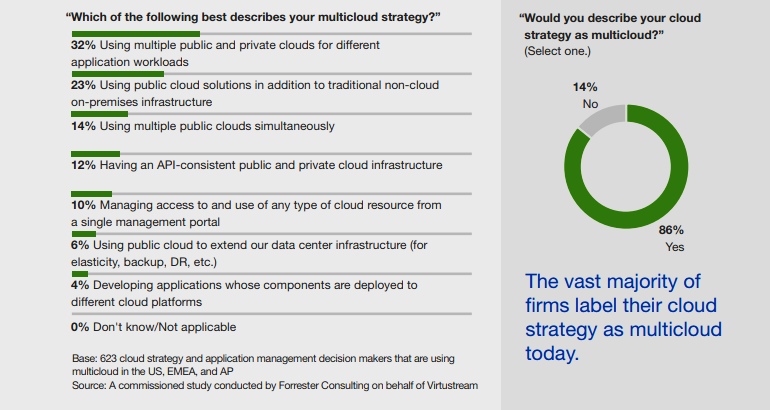
You can have highly available apps existing in one ideal cloud solution and actually sensitive data that you don’t need to access often in a different cloud solution applying the best multi-cloud approach. This one might be slower but more secure—and that’s OK!
The continuous IT investment will optimize multi-cloud architecture and deployments to recognize actual strategic advantages and aspirations. Are you interested in a closer look at seven of the most influential drivers for multi-cloud investment?
Reasons Organizations Choose a Multi-Cloud Strategy
Recent Forrester research found that almost 80% of enterprises describe their strategy as a hybrid/multi-cloud one. Multi-cloud is quickly establishing itself to be the prospect of business across every sector. To prevent vendor lock-in, drive down costs, and ensure agility, many organizations are now looking to multiple clouds for their operational needs.
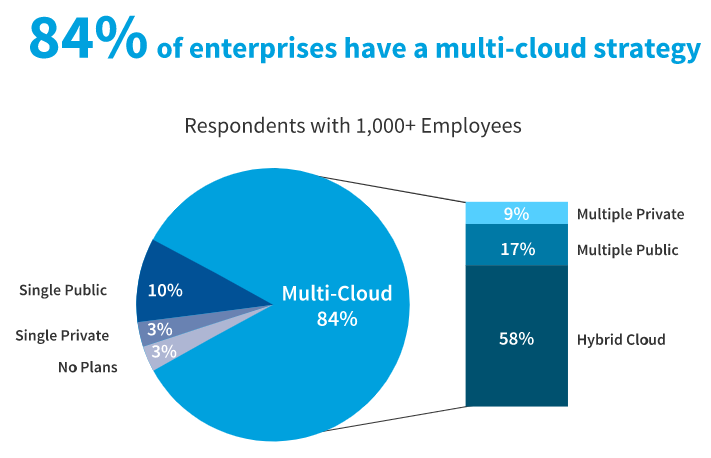
According to the same research, only 42% of organizations regularly optimize their cloud spending, and only 41% maintain an approved service catalog. So, it is always important to remember that without a strong understanding of what is being used and where organizations risk circumventing the benefits of a multi-cloud strategy and settling themselves with high budgets and security risks.

Avoiding Vendor Lock-In
Vendor lock-in occurs when an organization faces too much complexity to transfer its business apart from one cloud service provider to another provider or even bring its data back on-premises.
Organizations that rely on a single cloud service provider normally develop applications that depend profoundly on the unique potentials of that vendor. As those organizations broaden their investment in that single cloud, switching providers becomes more expensive, complex, also takes an enormous time.
In contrast, organizations that already have devoted themselves to a multi-cloud strategy purposely plan for agility and flexibility between multiple cloud providers. With the adaptability to move applications between multiple public cloud vendors, organizations are poised to take recognition of new technologies from all providers and adopt the well-functioning or most cost-effective services for specific application workloads.

Choosing a multi-cloud strategy can help your business avoid vendor lock-in, take support of new and better technologies from other providers, and adopt the most cost-effective and performance-enhanced compute or storage resources for each workload.
Overcoming Data Gravity
Data performs a significant role in daily operations for thousands of businesses. Organizations have traditionally kept their data in on-premises data centers where it could be spelled out by legacy applications, but in the cloud computing era, more are preferring to regulate data in the cloud and analyze them with cloud-based applications.
The term “Data Gravity” refers to the concept that large data sets are troublesome and expensive to move or migrate. If your organization keeps a large volume of data with a single cloud service provider, data gravity could push you to deploy related apps and services with the same provider—even when there are more cost-effective options accessible in another cloud.

Overcoming data gravity is as manageable as utilizing a cloud-attached storage solution that combines multiple clouds simultaneously. The best solutions minimize latency by hosting your data close to cloud data centers.
Better workload optimization
Whenever you approach any public cloud service provider, they offer their blend of physical infrastructure components and application services with versatile functionality, usage characteristics, terms & conditions, and pricing. They also release new features regularly to make their services more efficient, cost-effective, and attractive to customers.

Henceforth single cloud provider can’t claim to provide cost-optimized services that cover every potential business need or use case. But when you switch to a multi-cloud strategy, you can choose the most suitable cloud service provider for each application or workload, leading to enhanced application performance and improved cost-efficiency.
Elevating application performance
When cloud-based application services are released from servers at separate locations, data must travel across several network nodes before entering the user. In this pathway, slow data transfers may degrade application performance and negatively affect the user experience because of high network latency.
The market leaders of public cloud service providers (AWS, Azure, & Google Cloud) operate multiple data stations in geographically different regions, establishing a network of availability hotspots that deliver high-speed service to worldwide customers and users. By affirming a multi-cloud strategy and leveraging cloud services from the above one vendor, organizations can enter new geographies and implement better application and data performance for their users, wherever they are located.
Curbing Shadow IT
When autonomous business units within an organization select any technological solutions without the supervision of the IT department, shadow IT happens. Shadow IT leads to security concerns, notably whenever staff members use unsecured platforms outside of the organizational firewall to transact sensitive data. Based on the Gartner prediction in 2020, 30% or more successful cyberattacks will target Shadow IT resources within enterprise organizations.
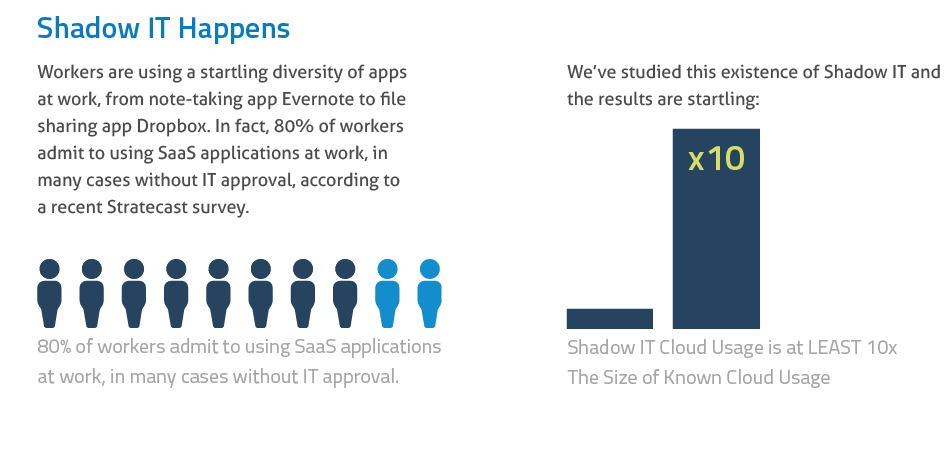
Organizations that are now adopting a multi-cloud approach can speed up their adoption of cloud services that drive employee productivity and collaboration, reducing the inducement for employees to execute new technologies without going through the channels.
Enhance disaster recovery capabilities!
A good number of public cloud service providers offer 99.5% uptime as part of their service level agreements — yet unplanned brownouts happen, and they can be extremely costly. According to a 2019 IT survey, it has been observed that organizations experienced an average of 830 minutes of unplanned downtime during the year, with an average cost of $5.6 million.
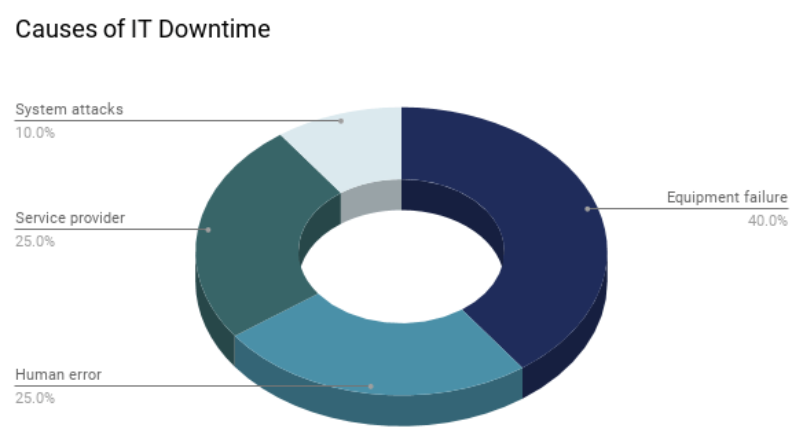
Organizations can respond to unplanned service outages by failing over their workloads from one public cloud to another with the help of a multi-cloud strategy. We provide our clients a customized solution on their failover models based upon application-specific needs, taking advantage of trade-offs between cost and performance to achieve a fully optimized disaster recovery strategy.
Meeting regulatory compliance and requirements
More organizations than ever now desire to meet regulatory compliance provisions referred to as data localization or data residency. Data localization laws may prohibit organizations from exporting data about a nation’s residents to other countries, requiring that the data be processed and locked away in the same region where it was collected.
Organizations can observe data localization or residency laws through a multi-cloud strategy by taking the assistant of cloud service providers with regional accessibility zones and data storage infrastructure.
Why should you choose Inovar to run your strategy?
Multi-cloud strategies are inherently complex. Legacy systems, disparate data sources, and different applications may start creating a unified plan for a momentous task. That’s why, to have multi-cloud perfect, more and more companies are searching for partners to help. The bespoke partners known as managed services providers help organizations embrace the cloud with speed, accuracy, and security.
There are many service providers out there. How do you understand which one is most competent for your organization?
According to the latest Forrester Wave: Multi-cloud Managed Services Providers report, enterprises should consider managed services providers that meet three criteria:
First, the provider should be able to uphold the organization during its entire cloud journey, from initial planning to migration, execution, and monitoring. At Inovar, we provide end-to-end services. We always try to know our pain points, requirements and suggest to you the best-suited solution. We offer you the supervision that you need to select the right capabilities to accomplish your business objectives- from cloud services to deployment, operation, and management.
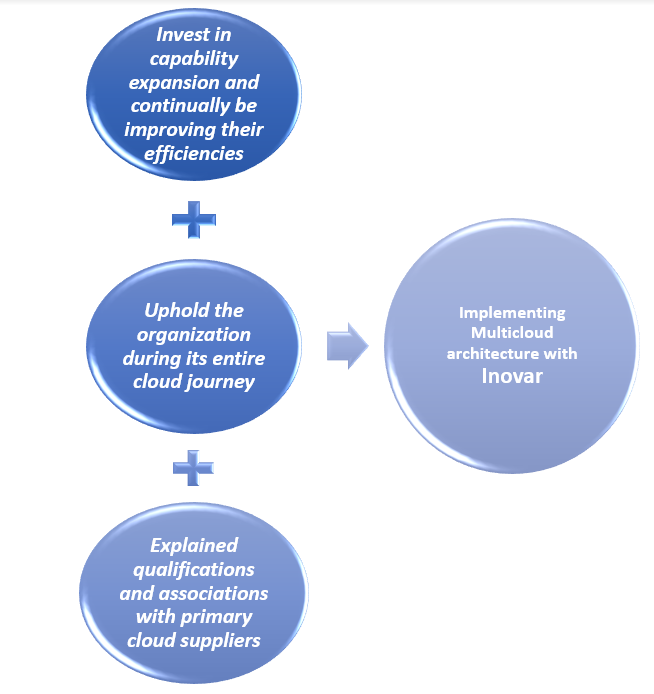
Secondly, providers must have the strength to invest in capability expansion and continually be improving their efficiencies. Cloud is one of the broadest platforms where technology is emerging constantly. Considering this fact, we always keep an eye on what is coming and suggest the best design strategy for resilience and success for years to come.
We maintain an atmosphere where you can promptly innovate, develop, obtain the ideal data at the right time, transfer workloads around as required, and draw full advantage of the latest progressions in AI, automation, analytics, and more so you can constantly iterate and enhance everything from applications to business processes. Starting from setting up your strategy to apply the best-automated approach, we try to ensure real-time optimization and help you build the skill sets you need to become more cloud-native.
Third, providers must have explained qualifications and associations with primary cloud suppliers. Our vendor-agnostic strategy lets you connect with the best services from well-known providers: Inovar multi-cloud platform is accredited by partners including Amazon Web Services (AWS) and Microsoft Azure for superb delivery and compliance to industry standards. Here you can find multiple options on the combination of vendors and get what you need.
Since most organizations are in business to generate money, we can safely say a multi-cloud strategy contributes to cash flow by taking care of money. Usually, challenges and solutions become more complicated when people address them sound more complex. But having the most suitable plan and the best people will ensure that your strategy lives for a very long time. If you are also looking for the same please reach out to us, we would love to collaborate.
Modern business means growing by the time and accommodate in a dynamic business world. Now Businesses do not have much time for training and coaching employees before starting any task as time is the most expensive resource, and every moment wasted in user training means a lot. That is where custom web application development turns into an ideal option among business owners. Furthermore, it will help to organize your business and keep all process unified that have an opportunity to work on what you need at the time.
Now the question is – why to opt for a custom web application development? As a business owner, you care to stand out from the crowd by building up a solid platform without compromising with product or service quality, then this is the way to go.
Decide the approach and explore available options
With the rapid advancement of technologies for both mobile and custom web apps, organizations fall into the dilemma of choosing the right medium to reach a targeted customer. The mobile application can run on a mobile device like a smartphone or tablet with the function of providing a service to its users. A web Application is a self-sustaining software run on the web browser that does not need to be downloaded and installed on the local machine of the end-user. But a custom web app would be the right choice for you if –
- Your webpage layout provides a better interface for your application
- Your targeted audience market prefers using browsers rather than a mobile
- You desire to apply dynamic updates to the entire application

(Source: www. caspio.com)
So, the main point is you need to determine the best suits approach for software application it may be related to the website or adopt a mobile-first technology or the combination of both approaches. After deciding on an approach, you need to explore the available option for a specific development.
Today, web application development platforms are using three types of development processes like no-code, low-code, and custom applications. Before selecting an option, let’s delve into what are these available options. No-Code: The visual development platforms do not need any coding skills for the application build. It allows using simple drag and drop of plugins to create functional applications, even the people who are not from a core technical background can we trained to use these platforms.
Low code: Low-code platforms support development more significant and modern way than no-code like the use of graphical interfaces with less programming than custom software development and offer minimal customization by coding as well if additional functionalities are required.
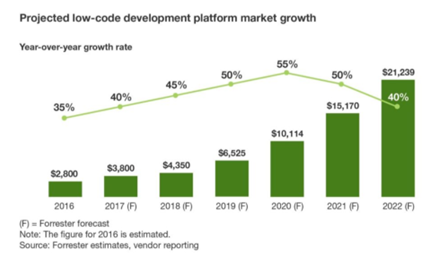
(Source: Forrester Report)
Custom development: Custom application development is the process of designing software applications for a specific user or a group of users within an organization. Developers design the custom application to address the specific needs within an organization that opposed to more traditional, standard software used by the masses.
Inovar develops custom applications that perfectly fit with your existing business software ecosystem and eliminates the need to use multiple applications for specific business functions. Depending on your business and technical requirements, we tailored a game-changing application solution for improving all your digital touchpoints.
Here we have mentioned all the possible options for you. Now it is your turn to dig deeper into how to pick the best approach that meets all business needs, and before moving forward, find out solutions align with your business goals.
Get a solution that fit your business goals
Once you choose the right approach next you have to choose the right app development methodology to apply modern software architecture, make software delivery faster, and meet your technical needs. There are multiple custom software development methodologies but select the right method is the most crucial part of every project. It is important that the project goals, definitions, and objectives are clearly stated at the nascent stage of the project. Companies can initiate the project once the complexities, client demand, and resources are sufficiently analysed.
Big bang methodology is mostly preferable for a simple and small project where clients are not aware of full requirements. The waterfall methodology is the most popular and oldest methodology of custom software development. On the other hand, RAD methodology focuses on the rapid development of your project. But A custom web development agency always prefers a process which fits their personnel and resources.
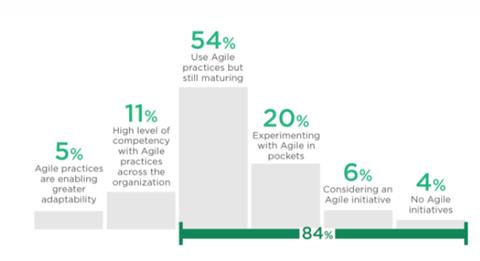
14th State of Agile methodology adoption
According to a statistical survey, 89% of the organizations have adopted agile methodology for its continuous delivery process, flexible features, and 83% of them conduct spring planning option as it involves incremental development, as well as developers can perform rapid iteration on a small chunk of the project. It also allows clients to get access to the project, review the work at each stage, implement changes constantly and share rapid feedback to the custom developer. In this way, we will help you to get an app with all facilities that will not be required to adjust too.
Benefits and support from full stack support developers
We all have seen how the COVID-19 virus spread like a forest fire and change business perception all over the world. After the new normal, the demand for remote work as well as the demand of Custom application on high. In case of custom web application development, you need full stack developers who will work as part of your teams and help to find solutions that you need.
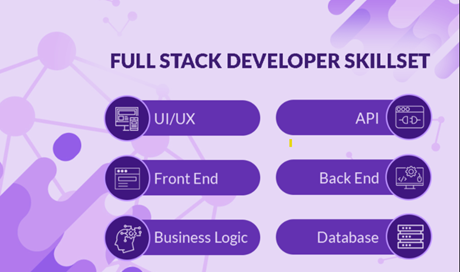
Support from full Stake Developers
Hiring a team of dedicated developers who can execute all the tasks related to the frontend and backend of the development becomes truly rewarding to build custom website applications. It prepares detailed customization on individual needs, makes the overall process highly structured, and leads the build of a steeler website. Inovar full stack developers orchestrate the capabilities to truly change the game, to take your business to the next level!
Choose the best suits based on your needs
From the above discussion, you are now well diverse with approaches and resources as well. Now it is your turn to choose the best suits for your business needs.
Adjust skill level with custom applications
According to the present situation, the most critical part is to pay attention to the user experience. The business decision-makers are aware of their workers and audience better than anyone else. Hence, they can create an interface that will complement their level of skills, engagement, and time. Custom app development is a lengthy process, and you can calculate its value in two different ways. If your employees use that app, then you could save a lot of time and deliver results within the deadline. On the other hand, if your customers ready to use that app, then you could analyse the positive and negative side of that app from their reviews.
Ensure Security with a unique set of protocols
Security is one of the tricky elements of custom web application development, and developers require a lot of attention while creating an independent system. If the application builds and runs seamlessly, then custom solutions can preserve business from hacking, cyber-attacks and ensure high security. The previous 5-year records are showing the effect of consistent improvement in high-risk vulnerabilities in web application development. According to Gartner, High-risk vulnerable code has dropped in web application 17% compared to the previous year. Still, companies need to apply a unique set of protocols from trusted sources and emphasize their constant updates.

Top five Web application attacks by Quarter of 2018
Stay true to your brand and improve efficiency
Recognizable brand image is the most crucial part of a good business strategy that impacts positively on business success in the long run. By developing a custom app for customers, you can offer customized solutions that you need to dazzle them. The custom app also creates a visual representation of your brand image and send the message to your customers.
Save your money as well as time in the long run
Custom web apps cost a little bit more than other app-dev processes, but the significance is they will save your money in the long run. By applying this customized intuitive tool, you will be more friendly with your budget and save money for future investment. Low-code or no-code platform is less time consuming as a custom app dev involved several steps starting with wireframing and website prototyping, designing the user interface, and software development and testing. But Custom app helps to make an attractive solution in less time in the long run.
Custom web application development is not an overnight process. Just remember one thing, you should begin with a clear vision of what you want to achieve. You will need a team of full stack developers as well who will be there to help you define the vision and work side-by-side with you to make your vision a reality.
The best thing about a custom web app is that you can tackle a single specific process or create an all-encompassing system that your entire business will run on. Whichever way you decide to go, it will still be just what you need.
If you have already decided to choose a custom web application platform for your business upliftment, then feel free to contact us and register for a free demo. We are here to help you!
The current business world is competitive for every small-medium, or a large business, as their success hinges on tech-innovation and the latest software technology. Today, information technology is one of the most critical functions for enterprises, but the IT consulting industry is booming up by the hour. Before we delve into the reasons behind the demand, and the increasing number of businesses outsourcing their IT work, let’s find out what IT consulting is!
Strategic IT consulting services help organizations better understand emerging technologies, implement correct design principles, and take a strategic approach to adopt tools and methodologies. IT consultant helps the company to assess its potential tech strategies and align those strategies with company goals and business needs.
How IT adjusting business strategies
IT leaders play the central role in strategizing decision to align technology with business goals. Businesses are now adopting the IT-business alignment model to optimize business value on every IT-related investment, activity, service, or project. Furthermore, improve the alignment of strategic IT consulting targets to achieve business-related metrics. IT business alignment is the sole of business that helps to understand how software technology plays a central role in business effectiveness, how it impacts competitiveness as well as response to continuous market change. Lastly, it can be mentioned that shared leadership and higher accountability is the key to successful IT-business alignment strategy.
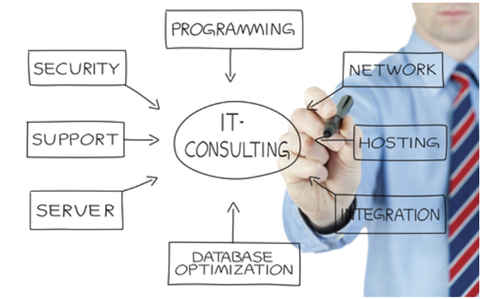
Why outsourcing IT consultancy services becomes necessary for business
As the business now becomes more technology-dependent, the need for high quality IT support has grown more than before. This need sometimes overwhelms many businesses with the complexities of handling their own IT support. Fortunately, the easiest way to solve this problem at the moment is to outsource strategic IT solutions from IT consulting service providers that are flexible, scalable, and convenient for business growth.
There are six artifacts behind IT outsourcing
Expertise at your fingertip
With rapid technology advancement, it becomes harder and difficult to stay on top of it. Here, Small businesses should utilize remote assistance from IT consulting specialists who offer design-led and sophisticated software solutions considering the business position. They are on hand to fix any issues and collaborate virtually to recommend the best virtual solution for any system—Round the clock.
Significant Financial Savings
The one of the major reasons to outsource your IT support is to result in substantial savings for your company. In-house IT technicians cost a high expense while businesses can save up to 40%* by outsourcing their IT tasks. In a large note, outsourcing IT support save on hiring and training internal IT staff as well as efficiently reduce administrative cost.
IT outsourcing is far more profitable for small and medium-sized businesses to enlist an external team to manage your requirements rather than bear the expense of the in-house team.
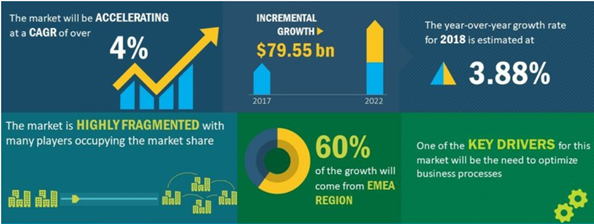
Shore up your cybersecurity
In today’s digitized business world, cybersecurity and sufficient data protection are paramount for business in all sizes. The situation becomes more difficult for regulatory changes without the additional burden of data security and malware threats. According to research, it has been noticed that small organizations face even greater cybersecurity risk than large organizations. The fact is every year, 60%* of small businesses are successfully hacked due to lack of security. Outsourcing security testing and monitoring allow businesses to enjoy full protection against any cyberattack, phishing attack without employing large force IT workers in such protection.
Manage Big Data Efficiently:
Now big data is the name of game as it is involving to improve customer relations, boost up sales and drum up more effective marketing strategies. But, sorting up all the data is not an easy task, a time constraint process. An outsourced IT consultant is here to save your day. They work to analyze your marketing and sales strategies by staking up your internal data from outside sources. IT consultants implement the right technology without wasting any time in staff training that often take a week or month.
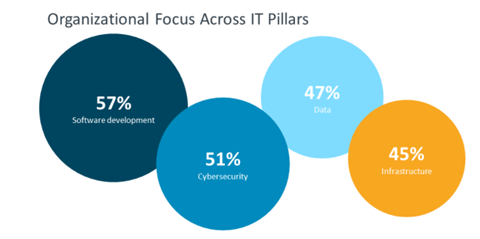
Improve remote work
Sun never sets on business that relies on global customer support. You cannot operate cyber threats or security attacks on the same 9-5 daily schedule because a technological issue can happen at any time of the day. Luckily, the IT consultant makes it easy by follow the Sun Model and improve global remote work support. They can handle any issues round the clock and support customer needs sitting across different worldwide locations follow this sun model. Even they also take care of other tasks like fixing bugs, installing software for specific applications, so there is no need to waste your precious time by doing these.
No Distractions
Puzzling over complex IT issues is time-consuming and makes employees away from serving excellent customer experience and growing business in the next level. By allowing the IT team of experts to fix complex problems ranging from networks to servers, other professionals can focus on really important aspects.
Strategic IT consultation and strategy services have a strong potential influence to make the team more productive, speed up business operations, and prompt new opportunities for the company. The business-IT alignment helps you to focus on the business goal, makes business investment reasonable, and support business innovation. It is now clear that a good business strategy is always backed with advanced technology. Hence, it is time to believe in the IT capabilities and take the initiatives to align the IT-business roadmap with strategic IT consulting services.
If you are stuck with any technical issues and looking for any IT consultation do not hesitate to contact us. Just fill the template and switch to a free trial. We would love to collaborate.
Reference:
* 4 great reasons to outsource your IT support, 3 POINTS Retrieved from: 3Points.com
CRM (customer relationship management) has become a real buzzword in the 21st Century business world. If you never used this term before then, you might have heard it echoing in every business domain. When your business looks at every transaction through the eyes of the customer, then you must believe in the simple philosophy of CRM, “put the consumer first,” to increase loyalty for your company.
Now, it does not matter if your company employs 10 people or more than 100 people- CRM software can establish a closer connection with customers, provide professional customer services, and grow business further. Now, 72%* of companies have started investing in modern technology, such as CRM, in demand for better ROI.

What is cloud CRM?
Traditional CRM systems were in-house applications, but today newer systems are cloud-based, which means the application and data both are held on the CRM providers’ servers in a datacenter and accessed via an internet browser. This cloud-based CRM or Software-as-a-Service (SaaS) CRM has lots of technical and financial advantages. According to The International Data Corporation (IDC) reports, IT Cloud services have seen an impressive lift-off in 2020, which stands for a 23%* growth compared to the previous five years.

In other words, things have changed a lot even the word ‘software’ has moved to the cloud from its old earth-bound domain because it is the exact place where businesses should look for the CRM solution.
10 benefits of cloud CRM:
1. Hassle-free installation
The fear comes first in the mind of the business decision-maker that CRM comes with a complicated installation process. But it is no longer valid. The modern cloud-based CRM is worry-free even, no business case is required for it.
There is no need for hardware and software maintenance or even a permanent IT person on site. You can complete the installation, migration, and system upgradation remotely.
2. No Upfront Cost
Anything cannot get easier than cloud CRM usage. After buying the software packages, all you need to do is log-in with access code, ensure uninterrupted fast internet connection from everywhere, and arrange a device to perform work.
Moreover, Cloud CRM operates on the pay-as-you-go subscription model, which requires a minimal upfront investment. There is no need for local servers to run the CRM system. So, there is no capital cost, no server software, and no maintenance. Monthly fee for a Cloud CRM package can be as low as €37*. By monthly or quarterly payment, you can reduce the financial risk and improve your company’s cash flow
3. Enterprise Grade Security
Security is a serious concern of every business using web-based information storage. According to Forrester Research, 51%* of businesses are wary of use cloud solutions known as SaaS due to security concerns. Web CRM data is always stored in redundant regional data centers, that would not cause downtime or data loss for problems at one data center. Governing data centers and the policies are certified with ISO-27001 as well as being certified by the Cloud Security Alliance (CSA), Cloud Computing Matrix (CCM).

These can be hosted on Government cloud (gov-cloud) as well if it’s a government or federal organization. Online CRM providers are much aware of all security issues and offer advanced automatized back-up policies that have clear data recovery plans if a breach happens.
4. CRM on the Move
Accessibility of the system is all-important for the salesperson so; they want some platform that could enable them to interact with the CRM tool in a seamless fashion. Round-the-clock accessibility is the immense benefit of Cloud-based CRM because this platform permits us to gain access from everywhere, in anytime with internet connectivity.
It is reliable to make some urgent, yet game-changing sales call, or send an amended sales proposal, or find a contact’s number or send an e-mail from any device when you are out of the office.

5. CRM, Power of collaboration
Within the cloud CRM framework, users can work jointly without any interference. It accredits unique login credentials to each team member that makes it possible to open multiple accounts all at once. Every cloud-based CRM is associated with thousands of partners that build a collaborative ecosystem. Dynamics CRM has office 365 and other partners that create strong networking in the whole ecosystem and bring the power of collaboration. This collaborative system improves customer interaction by availing customer data across teams for multi-channel interactions and retaining existing clients.
6. Advanced AI capabilities and Dynamic Dashboard
AI apps across customer service and sales are the latest online capability of cloud CRM software not available in OnPremise. Moreover, the organization insight dashboard will give you a visual representation of how your business is performing in the market. Users can analyze market trends, clear up the quantities, calculate the activities, and build their dashboard with easy instructions. It will help to inspect the performance of your team directly on the dashboard.
7. Effective to employee productivity
A cloud-based CRM program increases productivity in the workplace because it allows a team to operate more efficiently without being fastened to the office desk while tracking its customers. It also highlights the pace of team engagement with customers to derive feedback. With real-time data collection, it speeds up delivery of actionable leads and increases productivity levels across the board.

8. Reliable operation
Every business needs to maintain a lot of confidential customer information, and they require a system that allows periodic data back up and easy access in case of system break down. Incidents like data crash almost never happens with Cloud CRM as all parts of the cloud are backed up. In fact, a web-based CRM system maintains operational efficiency 99.99%* of the time with a robust data recovery process if any data breach occurs.
9. Endowed with agility
All virtual business components may affect software agility. But Agile cloud CRM software enables continual system access regardless of the device and makes users capable of certain changes as per the convenience.
10. Adaptable integration process
In a modern business environment, demand for flexible integration is on top. Cloud CRM can be integrated easily with other applications or software, such as Gmail and Office 365 products, including MS Office. That makes Cloud-based CRM an even more appropriate choice for your business.
Online CRM in workforce management during global pandemic
The novel-coronavirus pandemic is marked by uncertainty, and employees are adopting new ways of working to operate the business during the pandemic. A CRM can offer a 360-degree view of clients and stakeholders and take quick steps to address critical issues to establish best practices. The addon functionality of cloud CRM scales up marketing functionality with personalization capabilities and provides self-service rollout plans in response to COVID-19.
Furthermore, an automated CRM system makes employee remote work more collaborative with a customized database for interacting with potential target audiences. It is the time to empower your staff with result-driven software tools like cloud CRM and uphill your brand during this global crisis.
Reference:
* Plaksij. Z, 8 REASONS TO CHOOSE CLOUD-BASED CRM FOR YOUR BUSINESS Retrieved from: https://www.superoffice.com/blog/cloud-based-crm-for-small-business/
In 2020, low code speaks about a movement within technology because, in future, 50%*** of all new business applications will be created with this visual coding tool. If you are not familiar with the term low-code platform for app development, then get ready because you are about to start hearing it everywhere. Global businesses are now creating add-on pressure on developers in demand for multichannel applications to gain competitive advantage. In that scenario, low-code development platforms are accelerating the delivery of business applications with high productivity and offering better customer experience.
The worldwide low-code development platform market generated $10.3 billion revenue in 2019 and is expected to witness a CARG of 31.1% during the forecast period of 2020-2030**. Most of the tech companies consider low-code application platforms because it requires minimal coding and enables faster delivery with the help of pre-packages templates, graphic design techniques, and drag-n-drop tools. Below, three key factors work as driving force in this platform:
- Increasing demand for business digitization
- Less dependency on the information technology
- Stringent government norms on technology adoption

According to the Salesforce.com survey report, over 76%* of IT professionals were profoundly interested in low-code app development, which may scale up to 81% in 2021. More than half of the business is now happening using the low-code programming because developers consider this process viable for the development of the mission-critical application and high-level programming language.
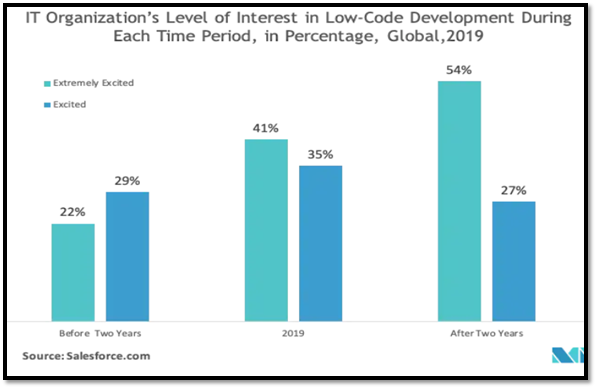
The rapid digital transformation has created a significant impact on major industries like Retail, BFSI, FMGC, E-Commerce, Media, and others. Undergoing process of digitization is a multi-faced journey, and not a single tool or approach will make the transformation to reality. But the bespoke platform can play a central role in the mixed method of digital transformation by reducing the load on IT and accelerating development time than traditional development process. This low-code solution empowers users to build solutions to meet their exact requirements that increase organization agility. This rapid transformation can evaluate the company brand position in this competitive market with a better customer experience.

The ongoing outbreak of COVID-19 is working as an additional fuel on the growth of low-coding platforms. This global pandemic pummels the economy, shredding profits and millions of jobs, now organizations are looking for a new platform to change. In that scenario, low-code automation is helping organizations adapt to massive disruption by quickly combining human and digital labor in the same workflow. COVID-19 has resulted in some of the complex problems mentioned below, for which low-code offers an excellent solution.
- Rapid business transformation in Retail and Healthcare
- Immediate need for applications
- A drastic shift in business strategy models
- Technical debt, and unavailability of talents become burden for companies

This pandemic has forced many small retailers and healthcare organizations to adopt or leverage their online marketing just for survival. Education, Pharma, and other small businesses are now depending on low-code solutions for an immediate need for new software applications. Self-reporting apps on disease symptoms, apps for online classes, government apps for the temporary service are now of outrageous demand. AD&D services in the insurance sector, airlines, retail, and healthcare are in the first row of low-code app demand. Moreover, cost of maintenance and update is quite low in this platform that can reduce company technical debt.
As per the Gartner report, Salesforce, Microsoft, Mendix are the topmost service leaders in fastest-growing low-code environment who have configured the cloud-native deployment options to minimize the operational risk and align organizational needs.

At Inovar, we are fully aware of the benefits of the low-code development platform and have aided one of the biggest healthcare centers in the US. We have helped them to migrate from their existing manual process to a low code solution to help patients amid this global pandemic. It was a comprehensive solution which included, dashboards, online forms where patients can ask any query or find details regarding doctor consultation quickly.
The old way of doing things might not die out completely, but people may be more reliable on low-code platforms as low-code programmers are going to lead the development environment. In a nutshell, in the era of rapid transformation, maybe companies won’t get much time to follow the lengthy development process or reinvent new wheels that can make apps redundant before they are even released. It will be the best time to believe in empowering IT developers and supporting them in creating a whole new ecosystem of application development.
Hence, do not allow yourself to be on the wrong side of history and empower your business with the right trend of the market.
References
* LOW CODE DEVELOPMENT PLATFORM MARKET – GROWTH, TRENDS, FORECASTS (2020-2025), Mordor intelligence, Retrieved from: https://www.mordorintelligence.com/industry-reports/low-code-development-platform-market
** Low-Code Development Platform Market Research Report: By Offering (Solution, Service), Deployment Type (Cloud, On-Premises), Enterprise (Large Enterprises, SME), Vertical (IT, BFSI, Retail, Healthcare, Government, Manufacturing, Media and Entertainment, Education, Energy and Utilities) – Global Industry Analysis and Growth Forecast to 2030, PRESCIENT& STRATEGIC INTELLIGENCE Retrieved from: https://www.psmarketresearch.com/market-analysis/low-code-development-platform-market
How Low-Code Technology Accelerates Digital Transformation Retrieved from:
https://www.businessprocessincubator.com/content/how-low-code-technology-accelerates-digital-transformation/